The Night Is Never Black


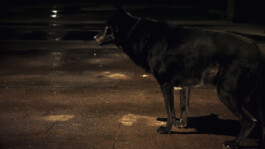

Mr. Nobel, 2016, 1-Kanal-Videoinstallation, Farbe, Ton, 10:29 Minuten, Produktion: AMA Film, Produktionsleitung und Schnitt: Andrea Roggon, Kamera: Paper Blattmachera
Mr. Nobel, 2016, 1-Kanal-Videoinstallation, Farbe, Ton, 10:29 Minuten, Produktion: AMA Film, Produktionsleitung und Schnitt: Andrea Roggon, Kamera: Paper Blattmachera
Mr. Nobel, 2016, 1-Kanal-Videoinstallation, Farbe, Ton, 10:29 Minuten, Produktion: AMA Film, Produktionsleitung und Schnitt: Andrea Roggon, Kamera: Paper Blattmachera
Mr. Nobel, 2016, 1-Kanal-Videoinstallation, Farbe, Ton, 10:29 Minuten, Produktion: AMA Film, Produktionsleitung und Schnitt: Andrea Roggon, Kamera: Paper Blattmachera
If all that remained was to archive nature
A conversation between Gabriela Oberkofler and Werner Meyer
Werner Meyer: At the centre of the exhibition Schwarz ist die Nacht nie (The night is never black) in the exhibition space of Kunsthalle Göppingen stands the Weihnachtsbaumarchiv(Christmas Tree Archive) installation (see pp. 8 – 10, 14, 17), which is a participatory scene dealing with the annual fate of Christmas trees. Approximately 60 trees, all cut to suit domestic size, stand densely packed in a wooden framework. Most of them are off-the-shelf Nordmann firs, but also other types of fir trees are amongst them. Here and there can be found the last vestiges of the decorations with which the Christmas trees once glitteringly composed the heart of the family celebrations and the rituals centred in the birth of Jesus. But now they are anonymous, shedding their needles, allowing their mortality to be felt. Arranged in this way it becomes clear that these trees, which but a short time ago were chosen with so much love, diligence and festivity to be the symbolic centre of one of the most important celebrations of Christendom, have had their day. On the other hand these few exemplary fir trees have been “rescued” for the moment from going without a song to the compost heap, and have received a chance to end their exceptional narrative and days in a different way.
Gabriela Oberkofler: Yes, I have “rescued” them from meaninglessness, even if I cannot reverse the natural process of their exploitation. Crucial to my exhibition is the melancholic sight, sometimes of enormous piles of discarded Christmas trees, which I witness every year after the 6th of January, after the Feast of the Epiphany that is, which is the celebration of the arrival of the Three Wise Men from the Orient. These tossed out Christmas trees which land by the wayside on these cold, grey wintry days, and have obviously, seen from afar, left their glory days behind them, were all picked up by me in a van and resurrected in the exhibition space of the Kunsthalle Göppingen. Thanks to the wooden framework that serves as a support, the trees have once again become a forest and an image, reminiscent of organised and efficient agricultural reafforestation, in which the trees obediently await their destiny, not ordained to them by nature but by human culture instead.



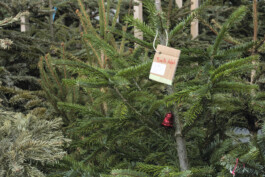
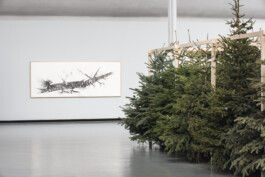
Weihnachtsbaumarchiv, 2016, 100 Weihnachtsbäume, Saison 2015, Holzkonstruktion, Archiv-Pappschachteln in diversen Größen; Installationsansicht Kunsthalle Göppingen, Foto: Frank Kleinbach
Weihnachtsbaumarchiv, 2016, 100 Weihnachtsbäume, Saison 2015, Holzkonstruktion, Archiv-Pappschachteln in diversen Größen; Installationsansicht Kunsthalle Göppingen, Foto: Frank Kleinbach
Weihnachtsbaumarchiv, 2016, 100 Weihnachtsbäume, Saison 2015, Holzkonstruktion, Archiv-Pappschachteln in diversen Größen; Installationsansicht Kunsthalle Göppingen, Foto: Frank Kleinbach
Umgefallener Baum, 2014, Tusche auf Papier, 114 × 300 cm, Sammlung Art.Plus Foundation, Donaueschingen; Installationsansicht Kunsthalle Göppingen, Foto: Frank Kleinbach
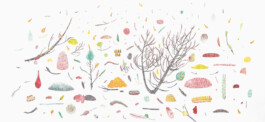
Latschenkiefer, 2016, Aquarell auf Papier, 114 × 280 cm
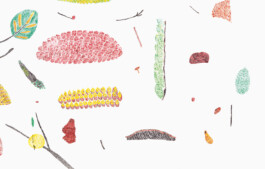
Detail Latschenkiefer, 2016, Aquarell auf Papier, 114 × 280 cm

Detail Latschenkiefer, 2016, Aquarell auf Papier, 114 × 280 cm


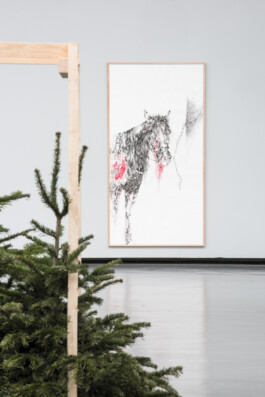


Weihnachtsbaumarchiv, 2016, 100 Weihnachtsbäume, Saison 2015, Holzkonstruktion, Archiv-Pappschachteln in diversen Größen; Installationsansicht Kunsthalle Göppingen, Foto: Frank Kleinbach
Weihnachtsbaumarchiv, 2016, 100 Weihnachtsbäume, Saison 2015, Holzkonstruktion, Archiv-Pappschachteln in diversen Größen; Installationsansicht Kunsthalle Göppingen, Foto: Frank Kleinbach
Pferd, 2016, Filzstift auf Papier, 200 × 114 cm; Installationsansicht Kunsthalle Göppingen, Foto: Frank Kleinbach
Weihnachtsbaumarchiv, 2016, 100 Weihnachtsbäume, Saison 2015, Holzkonstruktion, Archiv-Pappschachteln in diversen Größen; Installationsansicht Kunsthalle Göppingen, Foto: Frank Kleinbach
Weihnachtsbaumarchiv, 2016, 100 Weihnachtsbäume, Saison 2015, Holzkonstruktion, Archiv-Pappschachteln in diversen Größen; Installationsansicht Kunsthalle Göppingen, Foto: Frank Kleinbach
The Night Is Never Black




Mr. Nobel, 2016, 1-Kanal-Videoinstallation, Farbe, Ton, 10:29 Minuten, Produktion: AMA Film, Produktionsleitung und Schnitt: Andrea Roggon, Kamera: Paper Blattmachera
Mr. Nobel, 2016, 1-Kanal-Videoinstallation, Farbe, Ton, 10:29 Minuten, Produktion: AMA Film, Produktionsleitung und Schnitt: Andrea Roggon, Kamera: Paper Blattmachera
Mr. Nobel, 2016, 1-Kanal-Videoinstallation, Farbe, Ton, 10:29 Minuten, Produktion: AMA Film, Produktionsleitung und Schnitt: Andrea Roggon, Kamera: Paper Blattmachera
Mr. Nobel, 2016, 1-Kanal-Videoinstallation, Farbe, Ton, 10:29 Minuten, Produktion: AMA Film, Produktionsleitung und Schnitt: Andrea Roggon, Kamera: Paper Blattmachera
If all that remained was to archive nature
A conversation between Gabriela Oberkofler and Werner Meyer
Werner Meyer: At the centre of the exhibition Schwarz ist die Nacht nie (The night is never black) in the exhibition space of Kunsthalle Göppingen stands the Weihnachtsbaumarchiv(Christmas Tree Archive) installation (see pp. 8 – 10, 14, 17), which is a participatory scene dealing with the annual fate of Christmas trees. Approximately 60 trees, all cut to suit domestic size, stand densely packed in a wooden framework. Most of them are off-the-shelf Nordmann firs, but also other types of fir trees are amongst them. Here and there can be found the last vestiges of the decorations with which the Christmas trees once glitteringly composed the heart of the family celebrations and the rituals centred in the birth of Jesus. But now they are anonymous, shedding their needles, allowing their mortality to be felt. Arranged in this way it becomes clear that these trees, which but a short time ago were chosen with so much love, diligence and festivity to be the symbolic centre of one of the most important celebrations of Christendom, have had their day. On the other hand these few exemplary fir trees have been “rescued” for the moment from going without a song to the compost heap, and have received a chance to end their exceptional narrative and days in a different way.
Gabriela Oberkofler: Yes, I have “rescued” them from meaninglessness, even if I cannot reverse the natural process of their exploitation. Crucial to my exhibition is the melancholic sight, sometimes of enormous piles of discarded Christmas trees, which I witness every year after the 6th of January, after the Feast of the Epiphany that is, which is the celebration of the arrival of the Three Wise Men from the Orient. These tossed out Christmas trees which land by the wayside on these cold, grey wintry days, and have obviously, seen from afar, left their glory days behind them, were all picked up by me in a van and resurrected in the exhibition space of the Kunsthalle Göppingen. Thanks to the wooden framework that serves as a support, the trees have once again become a forest and an image, reminiscent of organised and efficient agricultural reafforestation, in which the trees obediently await their destiny, not ordained to them by nature but by human culture instead.





Weihnachtsbaumarchiv, 2016, 100 Weihnachtsbäume, Saison 2015, Holzkonstruktion, Archiv-Pappschachteln in diversen Größen; Installationsansicht Kunsthalle Göppingen, Foto: Frank Kleinbach
Weihnachtsbaumarchiv, 2016, 100 Weihnachtsbäume, Saison 2015, Holzkonstruktion, Archiv-Pappschachteln in diversen Größen; Installationsansicht Kunsthalle Göppingen, Foto: Frank Kleinbach
Weihnachtsbaumarchiv, 2016, 100 Weihnachtsbäume, Saison 2015, Holzkonstruktion, Archiv-Pappschachteln in diversen Größen; Installationsansicht Kunsthalle Göppingen, Foto: Frank Kleinbach
Umgefallener Baum, 2014, Tusche auf Papier, 114 × 300 cm, Sammlung Art.Plus Foundation, Donaueschingen; Installationsansicht Kunsthalle Göppingen, Foto: Frank Kleinbach

Latschenkiefer, 2016, Aquarell auf Papier, 114 × 280 cm

Detail Latschenkiefer, 2016, Aquarell auf Papier, 114 × 280 cm

Detail Latschenkiefer, 2016, Aquarell auf Papier, 114 × 280 cm





Weihnachtsbaumarchiv, 2016, 100 Weihnachtsbäume, Saison 2015, Holzkonstruktion, Archiv-Pappschachteln in diversen Größen; Installationsansicht Kunsthalle Göppingen, Foto: Frank Kleinbach
Weihnachtsbaumarchiv, 2016, 100 Weihnachtsbäume, Saison 2015, Holzkonstruktion, Archiv-Pappschachteln in diversen Größen; Installationsansicht Kunsthalle Göppingen, Foto: Frank Kleinbach
Pferd, 2016, Filzstift auf Papier, 200 × 114 cm; Installationsansicht Kunsthalle Göppingen, Foto: Frank Kleinbach
Weihnachtsbaumarchiv, 2016, 100 Weihnachtsbäume, Saison 2015, Holzkonstruktion, Archiv-Pappschachteln in diversen Größen; Installationsansicht Kunsthalle Göppingen, Foto: Frank Kleinbach
Weihnachtsbaumarchiv, 2016, 100 Weihnachtsbäume, Saison 2015, Holzkonstruktion, Archiv-Pappschachteln in diversen Größen; Installationsansicht Kunsthalle Göppingen, Foto: Frank Kleinbach